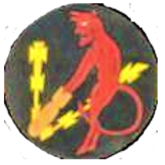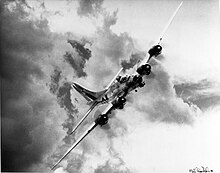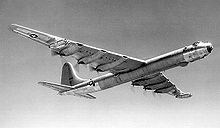Not to be confused with 348th Tactical Reconnaissance Squadron.
| 348th Reconnaissance Squadron | |
|---|---|
 A deployed squadron RQ-4 Global Hawk undergoes preflight checks before a mission in Southwest Asia A deployed squadron RQ-4 Global Hawk undergoes preflight checks before a mission in Southwest Asia | |
| Active | 1942–1945; 1947–1949; 1953–1974, 2011–present |
| Country | |
| Branch | |
| Role | Reconnaissance |
| Part of | Air Combat Command |
| Garrison/HQ | Grand Forks Air Force Base |
| Motto(s) | Northern Hawks (from 2012) |
| Engagements | European Theater of Operations Mediterranean Theater of Operations |
| Decorations | Distinguished Unit Citation Air Force Meritorious Unit Award Air Force Outstanding Unit Award with Combat "V" Device Air Force Outstanding Unit Award Republic of Vietnam Gallantry Cross with Palm |
| Insignia | |
| 348th Reconnaissance Squadron emblem |  |
| 348th Bombardment Squadron emblem |  |
The 348th Reconnaissance Squadron is an active United States Air Force squadron, assigned to the 319th Operations Group. It was activated at Grand Forks Air Force Base, North Dakota on 19 September 2011. It currently operates the RQ-4 Global Hawk, High Altitude Intelligence, Surveillance, and Reconnaissance Remotely Piloted Aircraft.
The squadron was first activated as the 346th Bombardment Squadron in 1942. After training in the United States, it moved to the Mediterranean Theater of Operations, where it earned two Distinguished Unit Citations in operations against the Axis Powers. After V-E Day, the squadron remained in Italy until November 1945, when it was inactivated. The squadron was activated in the reserves from 1947 to 1949, but does not appear to have been fully manned or equipped.
In 1953, the squadron was activated as the 346th Strategic Reconnaissance Squadron as part of Strategic Air Command. It returned to the bombardment mission two years later, and served in this role until inactivating in 1974. Although the squadron remained in the United States except for one deployment in the 1950s, during the Vietnam War it deployed its aircrews and Boeing B-52 Stratofortresses to Southeast Asia. For extended periods, all squadron personnel and equipment were deployed.
History
World War II

The squadron was activated in June 1942 as the 348th Bombardment Squadron, one of the four original squadrons of the 99th Bombardment Group, at Orlando Army Air Base, Florida, moving on paper the same day to MacDill Field, Florida. However, the Army Air Forces had decided to concentrate all heavy bomber training under Second Air Force, and before the end of the month, the squadron moved to Pendleton Field, Oregon to begin its training in Boeing B-17 Flying Fortresses. It continued training with the B-17 until January 1943, when it began deploying to the Mediterranean Theater of Operations.
The squadron's ground echelon went by ship from New York City to Marrakech, Morocco; the air echelon flew to Morrison Field, Florida, then along the South Atlantic Route. The ground and air echelons of the squadron were reunited at Navarin Airfield, Algeria in March 1943. It moved forward to Oudna Airfield, Tunisia after the Allies drove Axis forces from North Africa in May 1943. The squadron concentrated on targets such as airfields, harbor facilities, shipping, viaducts and bridges in North Africa, Sicily and Italy. In early June 1943, the squadron participated in Operation Corkscrew, the reduction of Pantelleria Island in preparation for the invasion of Sicily.
The squadron helped neutralize enemy fighter aircraft opposition to Operation Husky, the invasion of Sicily, penetrating enemy air defenses by bombing airplanes, hangars and fuel and ammunition storage sites at Gerbini Airfield. For these actions, it was awarded the Distinguished Unit Citation (DUC).

In November 1943, the 348th became part of Fifteenth Air Force, which focused on the strategic bombing campaign against Germany. The following month it moved to Tortorella Airfield, Italy. From this base, it engaged in the bombardment of enemy targets in Austria, Bulgaria, Czechoslovakia, France, Germany, Greece, Hungary, Italy, Romania, and Yugoslavia; attacking oil refineries, marshaling yards, aircraft factories, and other strategic objectives. On 23 April 1944, the squadron participated in an attack on aircraft factories in Wiener Neustadt, Austria, despite heavy enemy interceptor opposition. For this action, it was awarded a second DUC.
Following V-E Day, the squadron became part of the occupation forces in Italy, until inactivating in November 1945.
Air Force reserve
The squadron was again activated under Air Defense Command (ADC) in the reserve at Birmingham Municipal Airport, Alabama, on 19 May 1947 and again assigned to the 99th Group. Its training was supervised by ADC's 477th AAF Base Unit (later the 2587th Air Force Reserve Training Center). Although it was nominally a very heavy bomber unit, it is not clear whether or not the squadron was fully staffed or equipped with combat aircraft. In 1948 Continental Air Command (ConAC) assumed responsibility for managing reserve and Air National Guard units from ADC. President Truman’s reduced 1949 defense budget, however, required reductions in the number of units in the Air Force, ConAC also reorganized its reserve units under the Wing Base Organization, and the 19th Air Division and other reserve units at Birmingham Municipal Airport, including the squadron, were inactivated and replaced by the 514th Troop Carrier Wing in June 1949.
Strategic Air Command

The squadron was reactivated in January 1953 at Fairchild Air Force Base, Washington, when the 111th Strategic Reconnaissance Wing, an Air National Guard unit that had been mobilized for the Korean War, was returned to state control. The squadron assumed the mission, personnel, and Convair RB-36 Peacemaker strategic reconnaissance aircraft of the 111th Wing's 130th Strategic Reconnaissance Squadron, a regular unit assigned to the 111th Wing, which was simultaneously inactivated. The squadron engaged in worldwide strategic bombardment training and stood nuclear alert until 1956 when the B-36 was retired.

The squadron was re-equipped with Boeing B-52 Stratofortresses and continued training and nuclear alert status. It deployed aircrews and aircraft to the Pacific during the Vietnam War, engaging in Operation Arc Light combat missions over North Vietnam; also deployed aircraft and personnel to Thailand flying out of U-Tapao Royal Thai Navy Airfield for combat missions over Cambodia and Laos. It was inactivated in 1973 with the draw down of its parent 99th Bombardment Wing in anticipation of the transfer of Westover Air Force Base to the Air Force Reserve.
Air Combat Command
The squadron was reactivated under the 69th Reconnaissance Group in September 2011 as an RQ-4 Global Hawk Squadron. The squadron became part of the 319th Operations Group with the inactivation of the 69th Reconnaissance Group in June 2019.
Lineage
- Constituted as the 348th Bombardment Squadron (Heavy) on 28 January 1942
- Activated on 1 June 1942
- Redesignated 348th Bombardment Squadron, Heavy on 30 September 1944
- Inactivated on 8 November 1945
- Redesignated 348th Bombardment Squadron, Very Heavy on 13 May 1947
- Activated in the reserve on 29 May 1947
- Inactivated on 27 June 1949
- Redesignated 348th Strategic Reconnaissance Squadron, Heavy and activated on 1 January 1953
- Redesignated 348th Bombardment Squadron, Heavy on 1 October 1955
- Inactivated on 31 March 1974
- Redesignated 348th Reconnaissance Squadron on 17 August 2011
- Activated on 19 September 2011
Assignments
- 99th Bombardment Group, 1 June 1942 – 8 November 1945
- 99th Bombardment Group, 29 May 1947 – 27 June 1949
- 99th Strategic Reconnaissance Wing (later 99th Bombardment Wing), 1 January 1953 – 30 September 1973
- 69th Reconnaissance Group, 11 September 2011 – 27 June 2019
- 319th Operations Group, 28 June 2019 – present
Stations
|
|
Aircraft
- Boeing B-17 Flying Fortress, 1942–1945
- Convair RB-36 Peacemaker, 1953–1956
- Convair B-36 Peacemaker, 1953–1956
- Boeing B-52 Stratofortress, 1956–1973
- Northrop Grumman RQ-4 Global Hawk, 2011–present
- Northrop Grumman EQ-4 Global Hawk, 2011–present
Awards and campaigns
| Award streamer | Award | Dates | Notes |
|---|---|---|---|
| Distinguished Unit Citation | 5 July 1943 | Sicily, 348th Bombardment Squadron | |
| Distinguished Unit Citation | 23 April 1944 | Austria, 348th Bombardment Squadron | |
| Air Force Meritorious Unit Award | 1 June 2013-31 May 2014 | 348th Reconnaissance Squadron | |
| Air Force Meritorious Unit Award | 1 June 2016-31 May 2017 | 348th Reconnaissance Squadron | |
| Air Force Outstanding Unit Award with Combat "V" Device | 2-21 March and 15–31 March 1970 | 348th Bombardment Squadron | |
| Air Force Outstanding Unit Award | 1 October 1967-1 March 1968 | 348th Bombardment Squadron | |
| Air Force Outstanding Unit Award | 2 March-1 April 1968 | 348th Bombardment Squadron | |
| Air Force Outstanding Unit Award | 1 July 1971-30 June 1972 | 348th Bombardment Squadron | |
| Air Force Outstanding Unit Award | 1 June 2011-31 May 2012 | 348th Reconnaissance Squadron | |
| Air Force Outstanding Unit Award | 1 June 2014-31 May 2015 | 348th Reconnaissance Squadron | |
| Air Force Outstanding Unit Award | 1 June 2015-31 May 2016 | 348th Reconnaissance Squadron | |
| Vietnamese Gallantry Cross with Palm | 2 March 1969-31 March 1970 | 348th Bombardment Squadron |
See also
- Boeing B-17 Flying Fortress Units of the Mediterranean Theater of Operations
- List of B-52 Units of the United States Air Force
References
Notes
- Explanatory notes
- Approved 17 November 1958. Description: On an Air Force blue disc bordered Air Force golden yellow, a light blue globe turning on its axis bendwise grid lines Air Force blue; three white stylized aircraft, shaded Air Force blue leaving Air Force golden yellow condensation trails shaded brown; issuing from the globe four red lightning flashes, to dexter base and chief respectively.
- Aapproved 18 February 1944.
- Aircraft is Douglas Aircraft built Boeing B-17G-50-DL Flying Fortress, 44-6385 The Old Lady in 1944. This plane flew 58 missions and survived the war. On 17 December 1945 it went to Kingman Army Air Field for storage and was sold for scrap in August 1946. Baugher, Joe (24 August 2023). "1944 USAF Serial Numbers". Joe Baugher. Retrieved 24 October 2023.
- The American is TSgt. Bernard J. McGuire, Tonawanda, New York, of the 348th Bombardment Squadron.
- Citations
- ^ Ream, Margaret (8 September 2020). "Factsheet 348 Reconnaissance Squadron (ACC)". Air Force Historical Research Agency. Retrieved 25 October 2023.
- Maurer, Combat Squadrons, p. 432
- Watkins, pp. 76–77
- ^ Maurer, Combat Units, pp. 170-171
- Rodgers, pp. 16, 29
- ^ Ravenstein, pp. 281-283
- See Maurer, Combat Squadrons, p. 430 (no aircraft listed as assigned to the squadron from 1947 to 1949)
- "Abstract, Mission Project Closeup, Continental Air Command". Air Force History Index. 27 December 1961. Retrieved 24 March 2014.
- Knaack, p. 25
- "319th Air Base Wing Redesignates as 319th Reconnaissance Wing". Grand Forks Air Force Base. Retrieved 2 November 2019.
Bibliography
![]() This article incorporates public domain material from the Air Force Historical Research Agency
This article incorporates public domain material from the Air Force Historical Research Agency
- Maurer, Maurer, ed. (1983) . Air Force Combat Units of World War II (PDF) (reprint ed.). Washington, DC: Office of Air Force History. ISBN 0-912799-02-1. LCCN 61060979.
- Maurer, Maurer, ed. (1982) . Combat Squadrons of the Air Force, World War II (PDF) (reprint ed.). Washington, DC: Office of Air Force History. ISBN 0-405-12194-6. LCCN 70605402. OCLC 72556.
- Ravenstein, Charles A. (1984). Air Force Combat Wings, Lineage & Honors Histories 1947–1977. Washington, DC: Office of Air Force History. ISBN 0-912799-12-9. Retrieved 17 December 2016.
- Watkins, Robert A. (2009). Insignia and Aircraft Markings of the U.S. Army Air Force in World War II. Vol. IV, European-African-Middle Eastern Theater of Operations. Atglen,PA: Shiffer Publishing, Ltd. ISBN 978-0-7643-3401-6.
- Cowboy 57 (1959) James Stewart short on B-52 Crew from 348th
